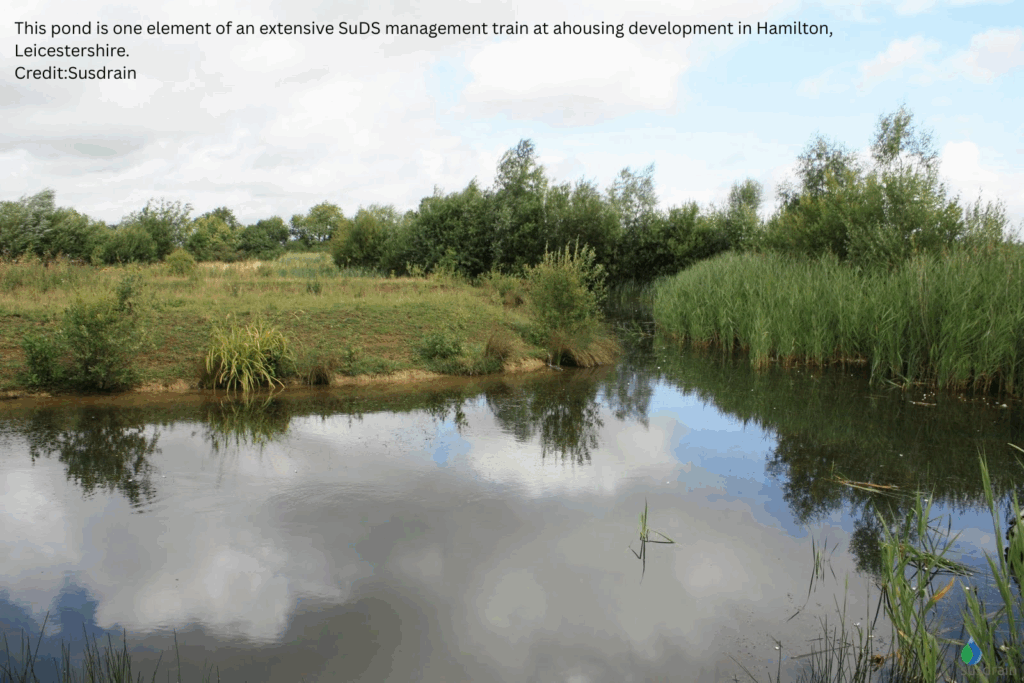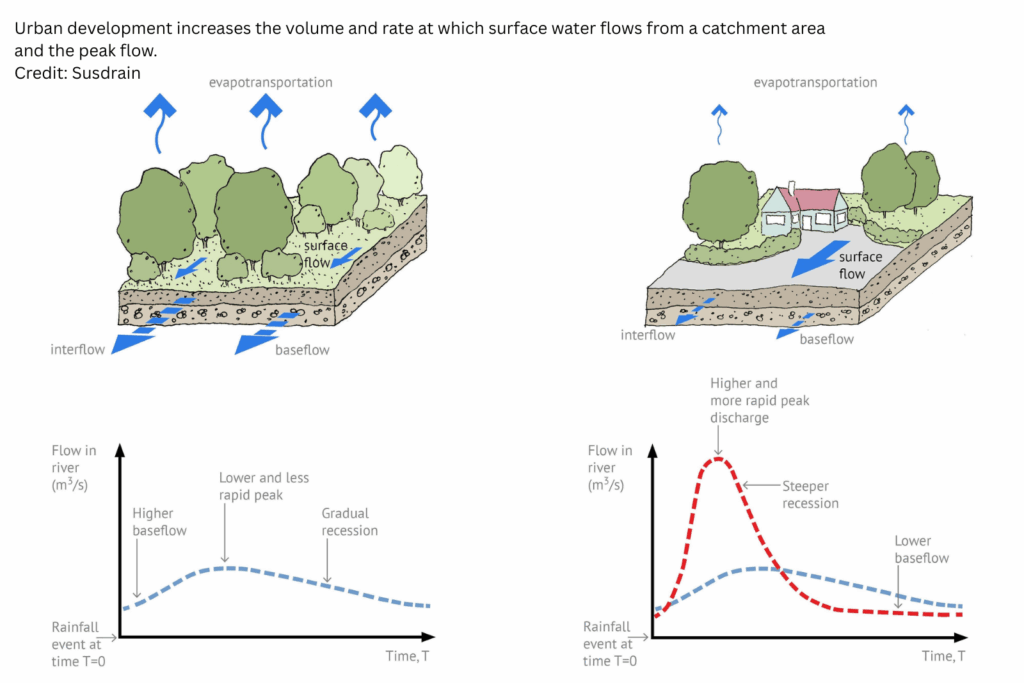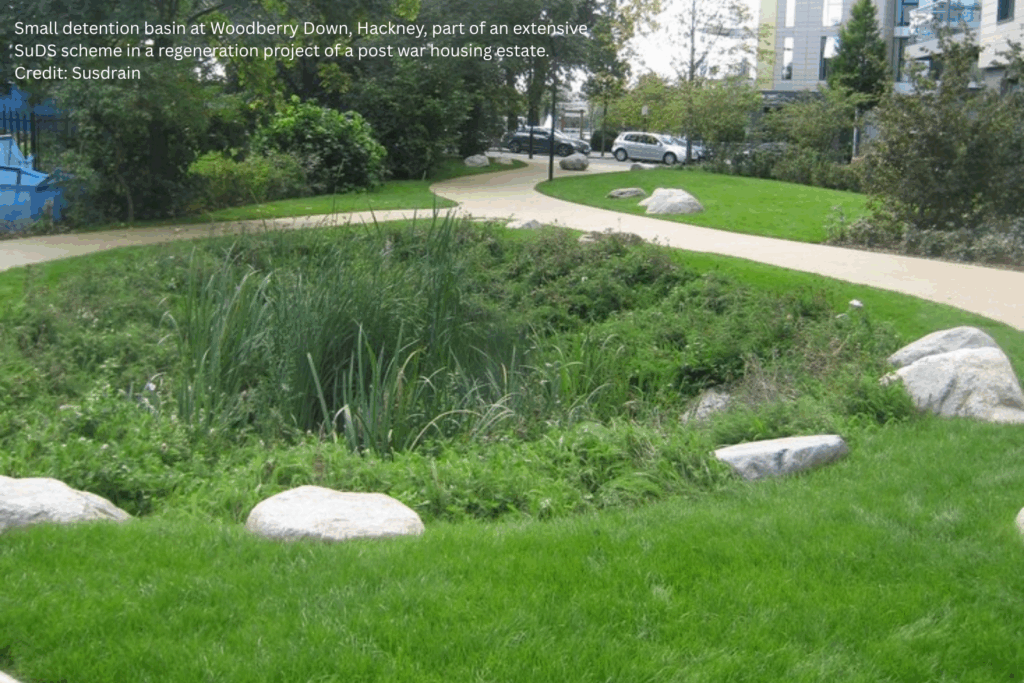
In this, the first of a two-part series considering the fundamentals of SuDS, Stuart Crisp, UK Manager, Advanced Drainage Systems asks if nature-based solutions are an automatic choice when specifying SuDS designed to mimic nature.
The weather so far this year has provided a stark reminder of the challenges we face due to heavy and intense rainfall. January’s Storm Henk brought a month’s rainfall in four days to some areas, leading to flooding, the worst of it in the Midlands. And in April, the impacts of Storm Kathleen and Pierrick caused flooding across the country,especially on parts of the south coast.
Ten English counties experienced their wettest September on record and for Bedfordshire and Oxfordshire, September 2024 was the wettest calendar month the counties have experienced, in a series dating back to 1836.
Much of this flooding is exacerbated by urban development. By replacing green fields and vegetation with hard surfaces–roads, roofs and driveways–we change the way and rate at which surface water flows out of an area or catchment.
A good SuDS design for water quantity aims to mimic the flows of water from developed sites so that they are as close as possible to what would have happened,had there still been a greenfield site there. That means throttling the flow of water–in other words providing storage and releasing it later, more slowly–so that it is not rushing so quickly into sewers and water courses and overwhelming them, leading to flooding.
Many policy documents from organisations that currently adopt SuDS–typically Scottish Water in Scotland, the county or unitary authority in Wales or a water company in England mandate natural or green SuDS, often prohibiting the use of proprietary or grey SuDS.
While green SuDS, such as swales and ponds are the right solution for some developments, a blinkered approach may not offer the optimum solution; capital costs could ramp up, it may fail to provide the lowest environmental impact and potentially lead to longer-term problems and higher maintenance and operation costs.
Although designing for water quantity and the urgent need to reduce the risk of flooding is vital, there are the other pillars of SuDS to think about too: water quality, amenity and biodiversity. Previous articles in Drain Trader’s June 2023 and February 2024 issues, looked at water quality issues and what type of management trains were best suited to different types of development, depending on pollutant loads.
Operational and maintenance costs for SuDS schemes are often overlooked and ignored, but the promised implementation of Schedule 3 of the Flood and Water Management Act 2010 in England will shed a harsh light on these. SuDS Approval Bodies (SABs), likely to sit within local authorities, will require robust information about inspection and maintenance regimes and expected costs over the lifetime of a development.
An article in Drain Trader’s March 2023 edition looked at why poorly thought-out SuDS can lead to shorter service lives and higher operational costs than those expected from the design.
Mimicking nature
On a greenfield site, the first 5mm of rain would not typically generate surface runoff, it would infiltrate into the ground, evaporate or transpire through the leaves of plants.Then, when water flows from the surface of a catchment and exceeds the capacity of the receiving water body, the additional volume of water would spill over onto the floodplain.
When we develop on that catchment to add impermeable surfaces, such as roofs, roads and hard standings, the amount of surface water runoff generated can increase dramatically. In a dense, urban environment, 95% of the rainfall could flow off the catchment as surface runoff, increasing the volume of water that reaches watercourses or sewers. It is also likely that the peak flow will be higher and come sooner,than had it remained a greenfield site.
CIRIA C753 The SuDS Manual gives a graphical illustration of this. Figure 3.1, in Chapter 3 which deals with design for water quantity, shows hydrographs for the discharge rates of surface water for an area in three situations: when it is greenfield; when developed without flow attenuation; and when developed with flow attenuation.(Figure 1 shows a similar graph, courtesy of SUSDRAIN).
The amount of water that a SuDS system will need to attenuate or store, and the rate at which the water should be discharged is the subject of the hydraulic design for that system. For those that want to go back to first principles, these are set out in BS EN16933-2 Drain and sewer systems outside buildings–Design–Part 2: Hydraulic design.

Today, however, many drainage engineers rely on software such as Info Drainage and Micro Drainage (AutoDesk/Innovyze), Flow (Causeway) and Site3D. But this ‘blackbox’ approach to calculations can mean that designers don’t have the opportunity to properly understand the assumptions and coefficients that have been used–and the impact on water quality based on the SuDS components selected to satisfy the hydraulic design–which may lead to suboptimal performance.
In a SUSDRAIN factsheet from March 2014, Assessing attenuation storage volumes for SuDS–another useful resource for designers–author Anthony McCloy explains the risks of this approach:
“Don’t expect exact answers from the calculation process, it is a usable approximation that can provide acceptable solutions for design. Most of the inputs are based on statistics and calibration factors; therefore we can only ever achieve an approximation of how the system will behave in reality. The results of calculations and modelling need to be used alongside professional judgement to provide the design.”
Ten years later, this point is just as relevant as ever, perhaps even more so as design software is more widely used, with newer generations of engineers never called on to design from first principles. McCloy also advises that those assessing potential SuDS,such as SABs, must also have a basic understanding of first principles of storage volumes and hydraulic design so that they can carry out their statutory duties.
Water storage toolbox
There are many ways that we can create storage for excess surface water. Storage can be online, meaning that flow enters the element, passes through and out the other side or offline where flow enters and exits via the same point. A design could include both online and offline storage where, for example, flow above the 1-in-30-year return period is directed offline to accommodate the 1-in-100-year event.
Vegetative or surface-based solutions include ponds, detention basins which are dry until excess water needs to be accommodated and swales which can be used to accommodate volume, as well as to communicate flow between SuDS elements and for infiltration.
Ponds can be an attractive choice, potentially ticking boxes for all the four pillars of SuDS. From a water quantity perspective, they must have sufficient capacity to cope with rising water levels during higher rainfall events throughout their design lives. Any sediment entering the pond will settle out quickly, since the sediment particles soon reach terminal velocity allowing them to settle to the bottom of the pond.

As an asset owner or adopter, it is important to anticipate the amount of sediment that will settle out over time, because the accumulated sediment must be somehow removed at intervals to allow the pond to provide sufficient storage volume. One issue that is sometimes overlooked in the design of ponds is providing safe and cost-effective means of accessing the pond to remove sediment when required.
A recent story from Gloucestershire illustrates the costs involved. Local residents petitioned Gloucester City Council in January this year to desilt Saintbridge pond in Abbeydale because it produces a foul smell in the summer and the silt is negatively impacting on water quality and habitats. The council refused, saying that it was only 15 years since it last desilted the pond and that the operation would cost £700,000.
Commenting on the story, Jo Bradley, director of operations at Stormwater Shepherds,pointed out the error of not having installed an upstream sediment separator at the same time as the pond. “If a manufactured sediment separator had been included, it could have been emptied every year, costing maybe £700-£1000. That would have cost up to £20,000 over the 20-year cycle and avoided the £700,000 cost that they are now facing.
”Bradley pointed out that by bringing in heavy plant every 20 years, removing vegetation and sediment, the pond’s habitats and inhabitants are disturbed, negatively impacting on nature. And she added that the sediment in the pond could well be contaminated with toxic, bio-accumulative pollutants and tyre-wear particles. CIRIA’s manual says that a sediment separator or sediment forebay should be installed upstream of every pond. And, depending on the pollutants likely to be washed into the pond with the surface water, other pre-treatment could be needed. Without this, there is a danger that wildlife will be attracted to the pond, only to suffer harm from the pollutants within it.
This point was illustrated by researchers at Glasgow University, who compared SuDS ponds with natural ponds and found that pollutants were higher in some of the SuDS ones, negatively affecting amphibian breeding and development. A paper published on the research issues this warning:
“The function of SuDS and other urban drainage systems to sequester pollutants increases their potential to be ecological traps by advertising false cues of suitable habitat.
”In the next issue, Stuart considers what the options are available when considering proprietary attenuation solutions.